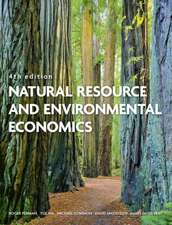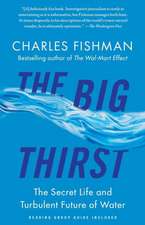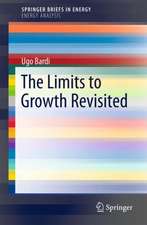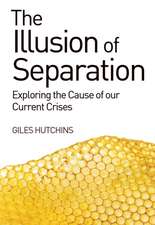Reinterpreting Sub-Saharan Cities through the Concept of Adaptive Capacity: An Analysis of Autonomous Adaptation in Response to Environmental Changes in Peri-Urban Areas: SpringerBriefs in Environment, Security, Development and Peace, cartea 26
Autor Liana Riccien Limba Engleză Paperback – 12 ian 2016
Din seria SpringerBriefs in Environment, Security, Development and Peace
-
 Preț: 380.07 lei
Preț: 380.07 lei -
 Preț: 378.54 lei
Preț: 378.54 lei -
 Preț: 384.31 lei
Preț: 384.31 lei -
 Preț: 382.95 lei
Preț: 382.95 lei -
 Preț: 382.95 lei
Preț: 382.95 lei -
 Preț: 385.84 lei
Preț: 385.84 lei -
 Preț: 386.61 lei
Preț: 386.61 lei -
 Preț: 379.09 lei
Preț: 379.09 lei -
 Preț: 377.95 lei
Preț: 377.95 lei -
 Preț: 411.75 lei
Preț: 411.75 lei -
 Preț: 409.43 lei
Preț: 409.43 lei -
 Preț: 379.30 lei
Preț: 379.30 lei -
 Preț: 379.09 lei
Preț: 379.09 lei -
 Preț: 381.98 lei
Preț: 381.98 lei -
 Preț: 379.09 lei
Preț: 379.09 lei -
 Preț: 379.86 lei
Preț: 379.86 lei -
 Preț: 377.35 lei
Preț: 377.35 lei -
 Preț: 344.64 lei
Preț: 344.64 lei -
 Preț: 380.25 lei
Preț: 380.25 lei -
 Preț: 378.34 lei
Preț: 378.34 lei -
 Preț: 484.47 lei
Preț: 484.47 lei -
 Preț: 386.81 lei
Preț: 386.81 lei -
 Preț: 378.92 lei
Preț: 378.92 lei -
 Preț: 377.73 lei
Preț: 377.73 lei -
 Preț: 379.09 lei
Preț: 379.09 lei -
 Preț: 379.68 lei
Preț: 379.68 lei -
 Preț: 378.92 lei
Preț: 378.92 lei - 5%
 Preț: 389.32 lei
Preț: 389.32 lei -
 Preț: 378.92 lei
Preț: 378.92 lei -
 Preț: 376.80 lei
Preț: 376.80 lei -
 Preț: 445.88 lei
Preț: 445.88 lei -
 Preț: 378.71 lei
Preț: 378.71 lei -
 Preț: 379.09 lei
Preț: 379.09 lei -
 Preț: 444.74 lei
Preț: 444.74 lei -
 Preț: 447.41 lei
Preț: 447.41 lei -
 Preț: 410.94 lei
Preț: 410.94 lei
Preț: 383.93 lei
Nou
Puncte Express: 576
Preț estimativ în valută:
73.47€ • 79.78$ • 61.72£
73.47€ • 79.78$ • 61.72£
Carte tipărită la comandă
Livrare economică 22 aprilie-06 mai
Preluare comenzi: 021 569.72.76
Specificații
ISBN-13: 9783319271248
ISBN-10: 3319271245
Pagini: 150
Ilustrații: XII, 211 p. 21 illus., 17 illus. in color.
Dimensiuni: 155 x 235 x 12 mm
Greutate: 0.32 kg
Ediția:1st ed. 2016
Editura: Springer International Publishing
Colecția Springer
Seria SpringerBriefs in Environment, Security, Development and Peace
Locul publicării:Cham, Switzerland
ISBN-10: 3319271245
Pagini: 150
Ilustrații: XII, 211 p. 21 illus., 17 illus. in color.
Dimensiuni: 155 x 235 x 12 mm
Greutate: 0.32 kg
Ediția:1st ed. 2016
Editura: Springer International Publishing
Colecția Springer
Seria SpringerBriefs in Environment, Security, Development and Peace
Locul publicării:Cham, Switzerland
Public țintă
ResearchCuprins
Introduction.- Citiesof Sub-Saharan Africa: Failed or Ordinary Cities?.- Interpreting theSub-Saharan City: Approaches for Urban Development.- Environmental Managementand Urbanization: Dar es Salaam as an Illustrative Case.- Adaptive Capacity as a Strategic Elementfor Reducing Vulnerability to Environmental Changes.- Conclusions: The DistanceBetween Critical Review and Institutional Commitment.
Notă biografică
Liana Ricci is an Environmental Engineer and has a PhD in Urban Planning. She is currently post-doc fellow at Department of Civil, Building and Environmental Engineering, SAPIENZA University of Rome in Italy. Her major fields of specialization are urban and environmental planning in sub-Saharan cities, adaptive capacity assessment, climate change adaptation mainstreaming into urban policy and plans and urban policy mobility. Liana has conducted research in methodology development for data collection and analysis on spontaneous practices for climate change adaptation in urban areas of the Least Developed Countries, Local, and in Environmental Planning and Management in peri-urban areas. Her work has been presented at several national and international conferences and workshops (INURA; AESOP; ICSS 2010; European Ph.D. Network on International Climate Policy 2010; Ph.D. Workshop on Sustainable Development Columbia University 2011, UICCA conference, Turin 2011 and 2013, UGRG 2014). In 2013 she was blue book trainee at European Commission DG CLIMA working as Policy Assistant in the team for Mainstreaming of Climate Action into Cohesion Policy for the programming period 2014-2020 and in macroregions, and supported the development of Knowledge Gap Strategy for Climate Action (Horizon 2020). During the same year she was also at UN Habitat for the Internship programme on Urban Planning to stimulate and contribute to research related to Cities and Climate Chance Initiative (CCCI) and participate in CCCI Technical Support Team.
Caracteristici
Includes original knowledge on autonomous adaptation and environmental management in Dar es Salaam Provides original integration of adaptation and urban planning concept in a post-colonial framework Presents a new perspective on coupled human-environment system and its relevance for adaptation Includes supplementary material: sn.pub/extras













